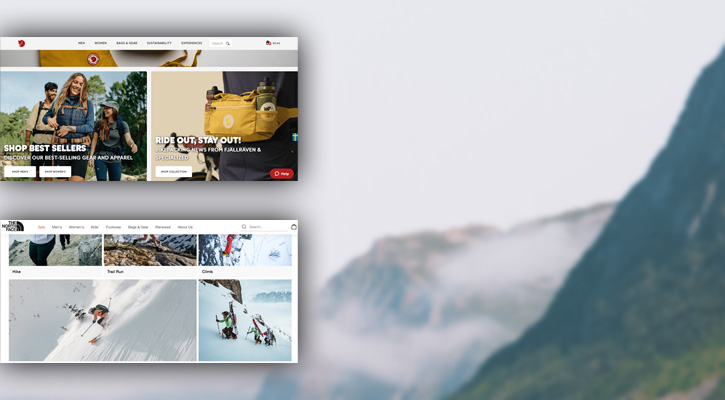
Both Fjällräven and The North Face are renowned outdoor gear brands, but they’re particularly famous for their winter jackets and their backpacks.
Both have long and rich histories of designing functional products for outdoor exploring and everyday use.
In today’s article, we’ll compare Fjällräven and The North Face to help you decide which of the two may work best for your needs.
We’ll look at their product lines, materials, sustainability efforts, prices, and more.
Ready? Let’s begin!
Key Points:
- Fjällräven is a Swedish company born in 1960, known for its minimalist style and durable and innovative outdoor gear including backpacks, jackets, etc. The Kånken backpack, Expedition jacket, and Nuuk parka are iconic products.
- Fjällräven is known for its meticulous production. It uses materials such as G-1000 and Eco-Shell fabrics, natural down insulation, synthetic G-Loft Supreme insulation, etc.
- The North Face, an American brand born in 1966, offers a wide range of outdoor gear, including technical mountain clothing, equipment, and lifestyle pieces. The Borealis backpack, McMurdo jacket, and Nuptse jacket are popular products.
- The North Face uses Gore-Tex, DryVent, and FUTURELIGHT technologies, natural down insulation, and Thermoball synthetic insulation. It offers quality and durability.
- Both use ethical material sourcing.
- Fjällräven is slightly more expensive.
- In the end: both offer comparable quality. The North Face may have an edge in terms of price, variety, and brand recognition.
- We’d choose Fjällräven.
Contents:
1. Fjällräven Outdoor Gear
History of the Brand
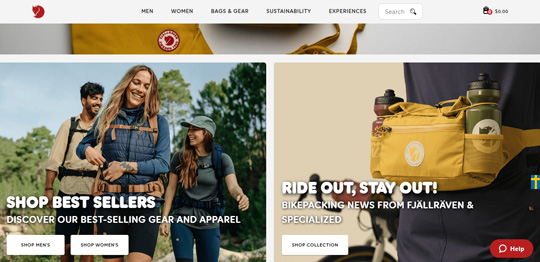
Fjällräven official website
Fjällräven, a Swedish company, derives its name from the Arctic Fox, which you can also see it depicted in the brand’s logo.
Founded in 1960 by Åke Nordin, an avid hiker with a vision to create a backpack capable of carrying heavier loads without straining the spine, the company initially sold its innovative backpack locally.
Recognizing the demand for lightweight and supportive backpacks, Fjällräven was established to meet this market need.
In the 1970s, the company introduced the Kånken backpack to address back issues experienced by Swedish schoolchildren, caused by inadequate backpacks for carrying books. Today, the Kånken backpack is a popular product, serving not only as a school bag but also as a trendy daily accessory.
Other notable products include the Expedition jacket, the Greenland jacket, and the Nuuk parka.
Over time, Fjällräven has expanded its product line to include waxed jackets, insulated winter coats, trekking and casual backpacks, hiking pants, sleeping bags, and camping tents, offering a comprehensive range for outdoor enthusiasts.
Don’t miss:
9 Outdoor Brands like Fjällräven: Our Favorites
Fjällräven vs Columbia Outdoor Gear (A Comparison)
Materials, Fabrics, and Production Process
Fjällräven has gained a great reputation for crafting durable jackets and backpacks designed for longevity, making it a preferred choice among outdoor enthusiasts.
The brand’s meticulous production process is evident in the careful selection of materials, including the versatile and breathable G-1000 fabric, which can be waxed for adaptability in various weather conditions.
Additionally, Fjällräven ethically sources natural down from ducks and geese for insulation in winter parkas and insulated jackets, while also incorporating sustainable practices by using recycled polyester in its products, such as Eco-Shell, a lightweight and weather-resistant material.
The video will be loaded from YouTube.com, a third party. If you play it, you accept their terms of service, and their use of cookies.
Read also:
Is Fjällräven Ethical and Sustainable?
Fjällräven vs Patagonia Outdoor Gear (Which is Better?)
Where is Fjällräven outdoor gear made?
Fjällräven produces most of its outdoor gear in different Asian countries, such as China, Vietnam, and South Korea. (more information here)
Recommended Products
Fjällräven Expedition Men’s Down Jacket

Image: fjallraven.com
Check it out at Fjallraven.com
The Expedition Down Coat, a renowned product from the 1970s, is made from a mix of Nylon and Polyester and features ethically sourced down insulation. True to its name, it is an exceptionally warm jacket, ideal for difficult expeditions.
The high cost of the coat mirrors its excellent quality and attention to detail, and we anticipate nothing less for such a piece of gear.
Read also: Haglöfs vs Fjällräven Outdoor Gear: A Comparison
Fjällräven Classic Kånken Backpack
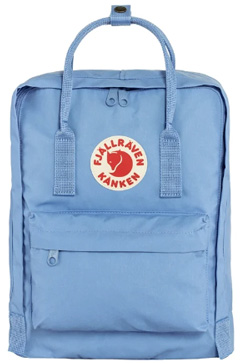
Image: fjallraven.com
Check it out at Fjallraven.com
Using the durable Vinylon F material (100% vinylal), the Kånken backpack is very robust. Its water-repellent properties and careful craftsmanship further enhance its value.
Beyond its utility for educational purposes, this backpack is also great as a versatile everyday item for transporting laptops, tablets, and other belongings.
Read also: Fjällräven vs Helly Hansen (Side-by-Side Comparison)
Prices
Fjällräven is a mid-to-high-end outdoor brand, offering items like backpacks ranging from $60 to $400 and jackets priced between $150 and $1000. The insulated winter parkas stand out as the priciest options among their offerings. The Expedition coat, for example, goes for around $750!
Are Fjällräven products worth the price?
In our opinion, Fjällräven is worth it! We appreciate their essential designs, a bit retro-looking, and the sturdiness of their items is very much appreciated by consumers all over the world. The insulation is excellent, and the construction is robust.
Learn more: Why is Fjällräven so Expensive? Are Its Products Worth It?
2. The North Face Outdoor Gear
History of the Brand
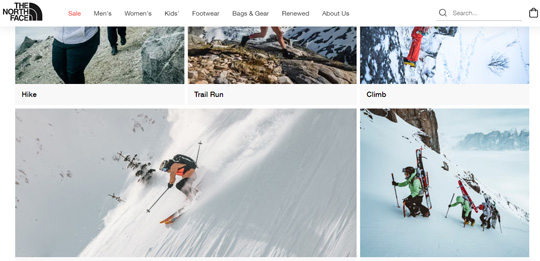
The North Face’s official website
The North Face, a renowned American brand in the outdoor gear market, has gained a strong following among outdoor enthusiasts since its establishment in 1966.
Initially focusing on technical mountain clothing and equipment such as hiking backpacks, tents, and skiwear, the brand’s appeal expanded beyond the technical wear niche in the 1990s, attracting a celebrity clientele. For instance, a rapper featured the Steep Tech jacket in a music video in 1993.
The brand’s name is inspired by the coldest and most challenging face of a mountain in the northern hemisphere, known as “the north face”, the part of the mountain facing north.
Don’t miss:
11 Brands like The North Face: Our Top Alternatives
12 Best American Jackets and Outdoor Clothing Brands
Materials, Fabrics, and Production Process
The North Face utilizes primarily Nylon and Polyester, like most outdoor gear brands, and integrates multiple technologies into its products, such as the FUTURELIGHT membrane.
FUTURELIGHT incorporates a thin nanomembrane in jackets to enable airflow while repelling water, proving its waterproofing capabilities even in extreme outdoor conditions.
Additionally, the brand employs goose down for thermal insulation, ensuring comfort and warmth during extended excursions, while maintaining a light weight to facilitate freedom of movement.
Many of The North Face’s jackets and other products use the renowned Gore-Tex technology, which enhances waterproofing, windproofing, and breathability in its apparel. Gore-Tex effectively allows moisture to escape while preventing water from entering.
The brand has also developed other technologies including DryVent, WindWall, FlashDry, and the popular ThermoBall synthetic insulation.
The video will be loaded from YouTube.com, a third party. If you play it, you accept their terms of service, and their use of cookies.
Read also:
The North Face vs Helly Hansen Outdoor Gear: A Comparison
The North Face vs Berghaus: Which is Better?
Where is The North Face outdoor gear made?
The majority of The North Face outdoor equipment is manufactured in Asian countries like China, Bangladesh, India, and Vietnam, with some collections also produced in the United States.
Recommended Products
The North Face Men’s McMurdo Parka
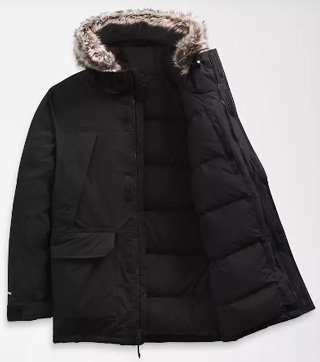
Image: thenorthface.com
Check it out at TheNorthFace.com
The Men’s McMurdo Parka has been crafted to deliver outstanding warmth and defense against the elements and wind. This coat boasts a comfortable fit and is filled with 600-fill recycled waterfowl down, making it an excellent option for cold climates.
The parka is both windproof and waterproof, as well as breathable, courtesy of its seam-sealed DryVent™ 2L shell featuring a non-PFC DWR finish. It is equipped with practical elements such as concealed, secure-zip chest pockets, two dual-entry front patch pockets, and a secure-zip internal chest pocket.
The parka also features an attached, three-piece hood with an internal drawcord for adjustability and a removable faux-fur ruff, along with a stormflap that conceals the two-way, VISLON® front zip. It’s adorned with an embroidered logo on the left chest and back-right shoulder, adding a dash of style to its functionality.
Adjustable hook-and-loop cuff tabs ensure a snug and comfortable fit, making the McMurdo Parka a versatile and dependable choice for braving severe-weather environments.
Read also:
The North Face McMurdo vs Fjällräven Nuuk: Which is Better?
The North Face Diablo vs. Nuptse: Which Jacket is Better?
The North Face Borealis Backpack
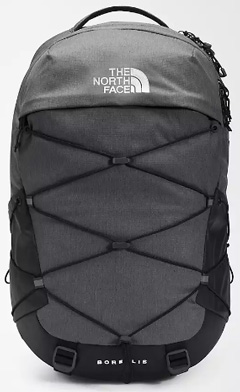
Image: thenorthface.com
Check it out at TheNorthFace.com
The Borealis Backpack stands out as a popular and adaptable pack, catering to everyday needs with a focus on security and practicality. Its distinctive bungee cord system and spacious interior compartment ensure the safekeeping of belongings, complemented by a stand-up design, detachable waist belt, sternum strap, and protective laptop section, making it suitable for diverse activities and settings.
Prioritizing comfort and support, the backpack incorporates the FlexVent™ suspension system for a comfortable fit, even during prolonged use. For organization, it features an external bungee-compression system, side bungee cords, and bottom compression, along with dedicated laptop storage, a sizable main compartment, and a front section with internal organization, secure-zip pockets, and a tablet sleeve.
Crafted from a blend of recycled nylon and recycled polyester, the backpack not only delivers functionality but also reflects sustainable principles. With its practical features and considerate design, the North Face Borealis Backpack proves to be a dependable and adaptable option for daily use.
Read also: How To Wash a North Face Backpack: Step by Step
Prices
The pricing of The North Face’s items tends to be higher compared to numerous other outdoor gear brands. Despite this, the brand typically falls within the mid-to-high price bracket.
For example, their jackets are priced between around $70 and $800, while their backpacks range from $50 to around $300.
Are The North Face products worth the price?
If you’re an enthusiast mountain hiker, skier, or adventurer, The North Face’s gear justifies its cost in our opinion. Their equipment is crafted to deliver the comfort, utility, and performance that you demand.
However, when it comes to casual wear and gear, it depends on what you expect. But even then, there are also affordable options available from this brand, making The North Face a good choice even for everyday outdoor wear.
Learn more: Why Is The North Face So Expensive and Popular? Are Its Jackets Worth It?
3. Which is Better? Fjällräven or The North Face?
Both are great. Obviously. But you came here for an answer. So, here are our considerations that will help you have a clearer idea for your next purchase:
Quality and Durability: Both are known for durable gear. Fjällräven uses materials like G-1000 fabric, Eco-Shell, and Vinylon F that are resilient, weather-resistant, and breathable. The North Face utilizes technologies like Gore-Tex, DryVent, and FUTURELIGHT to make its gear waterproof, breathable, and durable. Gore-Tex is among the most durable materials for outdoor use.
Insulation: Both use synthetic insulation (Fjällräven with G-Loft Supreme, The North Face with Thermoball) and natural down insulation from ducks and geese.
Ethical Practices: Fjällräven sources down ethically from ducks/geese and uses recycled polyester. The North Face also uses recycled materials like goose down and recycled nylon and polyester. So both focus on ethical material sourcing.
Production: Both make their gear mainly in Asia.
Price: Fjällräven products tend to be on the higher end, with backpacks from $60-400 and jackets from $150-1000. The North Face’s price range is a bit lower, with jackets from $70-800 and backpacks $50-300. So Fjällräven is more expensive on average.
Style: Fjällräven is known for its minimalist, rugged styles, with a bit of a retro look. The North Face also offers technical styles but has expanded into more fashion-forward lifestyle pieces and has a broader appeal in terms of style.
In the end, Fjällräven may be more expensive but is excellent for rugged, simplistic styles, and durable gear. The North Face offers comparable quality at a slightly lower price and has a wider variety of technical and lifestyle designs.
You can’t go wrong with either, but The North Face may have a slight edge in terms of price, variety, and brand recognition. We’d personally choose Fjällräven anyway.
Let us know what you think in the comments.
Read next:
11 European Brands for Outdoor Enthusiasts: Our Top Picks
9 High-End, Expensive Hiking Brands for Clothing and Footwear
